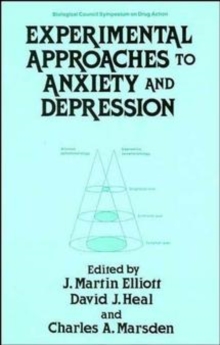The title of the Biological Council Symposium for 1991 - "Experimental Approaches to Anxiety and Depression" - indicates a growing change in the way both psychiatrists and experimental neuroscientists view these two mental diseases.
In the past, depression and anxiety were neatly compartmentalized into distinct boxes with the amine uptake inhibitors and monoamine oxidase inhibitors used to treat depression and the benzodiazepines anxiety.
Similarly it was generally assumed that the biological basis of the two diseases differed, with involvement hypothesis to explain anxiety.
Since that time our understanding of the basic pharmacology of the neurotransmitters in the brain has advanced rapidly and we now know there are multiple receptors for noradrenaline, serotonin and gamma-aminobutyric acid (GABA). Associated with these advances have come many new drugs that act on the various receptor subtypes, providing more selective probes to investigate the role of neurotransmitters in specific behaviours.
Meanwhile the clinicians seem to have become less sure of the original neat classification of two diseases, with the margins between anxiety and depression becoming blurred.
The combination of increased basic knowledge and re-evaluation of the clinical profiles of anxiety and depression has induced a waryness in the pharmaceutical companies.
A quick scan through a journal such as "Current Opinion in Therapeutic Patents" indicates that for many of the new compounds, such as the 5HT1A partial agonists, the clinical indications state both depression and anxiety. The aim of the Biological Council symposium upon which this book is based was to reinvestigate aspects of the experimental and clinical evidence for the involvement of specific neurotransmitters in anxiety and depression in the light of new ideas and concepts.
Peter Tyrer presents evidence that the two diseases are not distinct clinical entities but rather variations of affective disorders.
A central problem in the development and testing of new drugs for mental disease is the availability of suitable animal models.
Sandra File examines the possibilities for anxiety while Roger Porsolt and Antoine Lenegre review the tests available to predict antidepressant actions. Michael Davis then describes the anatomy and psychology of the fear-potentiated startle reflex in the rat as a model of anxiety.
The second part of the book is concerned with neurochemical and neuropharmacological aspects of anxiety and depression.
David Kendall reviews the biochemical effects of antidepressant and anxiolytic drugs on receptor mechanisms while David Nutt and colleagues consider the evidence for a common noradrenergic dysfunction in anxiety and depression.
Trevor Sharp describes experimental results using brain microdialysis which suggest mechanisms by which 5-HT may be implicated in both anxiety and depression.
The role of GABA in both diseases is reviewed by Willy Haefely and he concludes there is a significant role for this transmitter in anxiety but not in depression.
Anne Stephenson extends the GABA story to the molecular level, describing how antibody-probes may be used to identify which of the GABAA receptor oligomers may have therapeutic value. There is increasing interest in the potential importance of dopamine in aspects of anxiety and depression.
Bob Fremeau and his colleagues demonstrate the localization of dopamine D1B receptor MRNA within limbic areas associated with mood and emotion.
Dennis Charney extends the biochemical aspects of the topic into man with a review of potential clinical biochemical markers of depression, concluding that with the development of new selective neuropharmacological tools, progress in this area should be made in the immediate future. The final part of the book attempts to bring together the main strands.
Firstly Trevor Robbins reviews the thinking behind attempts to develop animal models of mental illness, concluding that although the models will undoubtedly be flawed, the search is a worthy one.
Bill Deakin attempts to produce a unified mechanistic theory to explain the involvement of serotonin in both anxiety and depression, while Roger Buckett reviews likely developments in the introduction of novel and effective antidepressant and anxiolytic drugs in the near future.

